In the vast world of spiders, Pardosa lapidicina stands out as a species worth exploring. In this article, we’ll delve deep into its characteristics, habitat, and some lesser-known facts about this captivating spider.
The Stone Spider or ‘Pardosa lapidicina’ spider has some distinctive physical features that help in its identification.
Females carry a spherical egg sac made of silk, which is often pale and might contain dozens of eggs.
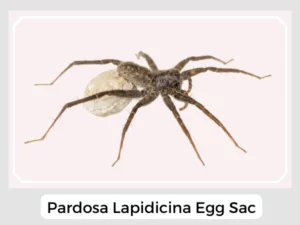
Photo Credit: Gilles Arbour
After hatching, the spiderlings are pale in color, and they gradually darken as they grow and molt.
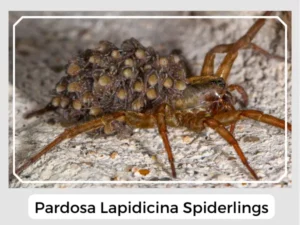
Photo Credit: John Guerin
Like many other wolf spiders, Pardosa lapidicina doesn’t create a traditional web. Instead, they are roaming hunters, relying on their speed and camouflage to catch prey.
Yes, like most spiders, Pardosa lapidicina possesses venom primarily used to immobilize their prey. However, it’s not harmful to humans.
Yes, while they can bite if threatened or provoked, it’s a rare occurrence. When it happens, the bite might cause slight itchiness or a mild burning sensation but poses no severe threat to humans.
The Stone Spider plays a crucial ecological role by regulating insect populations. As a predator, it helps to maintain a balance in the ecosystem, curbing the spread of insects in its habitat.
Natural Predator: Birds, small mammals, and larger spiders are among the natural predators of Pardosa lapidicina. This predatory relationship is vital for controlling their population, ensuring ecological equilibrium.
Prey-Predator Dynamics: Pardosa lapidicina spiders are proficient hunters that manage the insect population, thus serving a significant function in the food web. However, they are also prey to larger creatures, maintaining the delicate balance of nature.
Relationship with Humans: Stone Spiders generally have minimal interaction with humans. While capable of biting, incidents are rare and typically result in no more than minor irritation, posing no serious threat to our health.
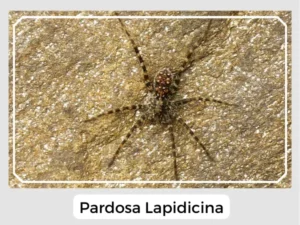
Photo Credit: Giff Beaton
| Distribution | Primarily found in Europe and some parts of North America |
|---|---|
| Habitat | Grassy fields, meadows, and woodland clearings |
| Diet | Mainly small insects and other spiders |
| Lifespan | 1-2 years on average |
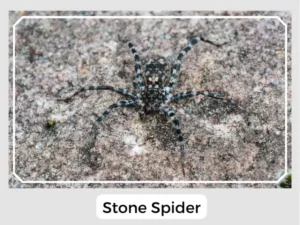
Photo Credit: Giff Beaton
In summary, the Pardosa lapidicina is not only a fascinating spider due to its hunting prowess and nurturing behaviors but also plays a vital role in controlling pests in its environment.
In the vast world of spiders, Pardosa lapidicina stands out as a species worth exploring. In this article, we’ll delve deep into its characteristics, habitat, and some lesser-known facts about this captivating spider.
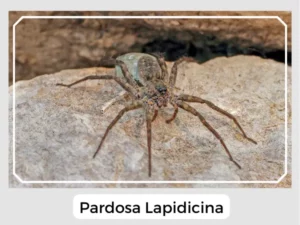
Photo Credit: John Guerin
The Stone Spider or ‘Pardosa lapidicina’ spider has some distinctive physical features that help in its identification.
Females carry a spherical egg sac made of silk, which is often pale and might contain dozens of eggs.

Photo Credit: Gilles Arbour
After hatching, the spiderlings are pale in color, and they gradually darken as they grow and molt.

Photo Credit: John Guerin
Like many other wolf spiders, Pardosa lapidicina doesn’t create a traditional web. Instead, they are roaming hunters, relying on their speed and camouflage to catch prey.
Yes, like most spiders, Pardosa lapidicina possesses venom primarily used to immobilize their prey. However, it’s not harmful to humans.
Yes, while they can bite if threatened or provoked, it’s a rare occurrence. When it happens, the bite might cause slight itchiness or a mild burning sensation but poses no severe threat to humans.
The Stone Spider plays a crucial ecological role by regulating insect populations. As a predator, it helps to maintain a balance in the ecosystem, curbing the spread of insects in its habitat.
Natural Predator: Birds, small mammals, and larger spiders are among the natural predators of Pardosa lapidicina. This predatory relationship is vital for controlling their population, ensuring ecological equilibrium.
Prey-Predator Dynamics: Pardosa lapidicina spiders are proficient hunters that manage the insect population, thus serving a significant function in the food web. However, they are also prey to larger creatures, maintaining the delicate balance of nature.
Relationship with Humans: Stone Spiders generally have minimal interaction with humans. While capable of biting, incidents are rare and typically result in no more than minor irritation, posing no serious threat to our health.

Photo Credit: Giff Beaton
| Distribution | Primarily found in Europe and some parts of North America |
|---|---|
| Habitat | Grassy fields, meadows, and woodland clearings |
| Diet | Mainly small insects and other spiders |
| Lifespan | 1-2 years on average |

Photo Credit: Giff Beaton
In summary, the Pardosa lapidicina is not only a fascinating spider due to its hunting prowess and nurturing behaviors but also plays a vital role in controlling pests in its environment.